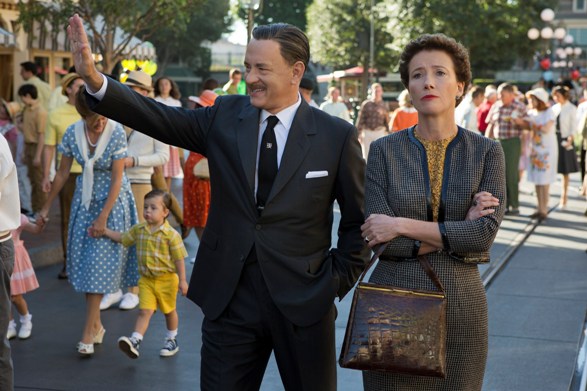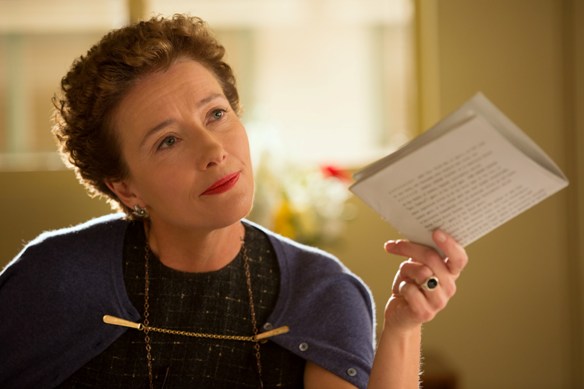Unalterably bookish, I grew up with two Mary Poppins: one had shiny black hair, large hands and feet, peering blue eyes and was impressively intimidating; the other was somehow softer, kinder, certainly more beautiful, and could sing like the birds, angels and other winged things. Both had up-turned noses, slid up banisters, and confirmed my fervent belief that magic is part of our lives every day. I never felt the need to choose, I loved them both and still do.

Yet it is not difficult to imagine that the creators of these respective personages were far more invested in the image of Mary Poppins, and its implied message. P. L. Travers introduced Mary Poppins to the world in the eponymous novel published in 1934. Vehemently opposed to musicals, animation, and any alterations to Mary’s character, Travers was averse to the idea of a film version. Despite Walt Disney’s ardent pursuit of film rights, it took many years of persistence, and apparently some suffering on both sides, before Travers gave her consent.
Saving Mr. Banks takes the viewer into the back-story of Mary Poppins the movie, and its two very different progenitors. Most of the action describes the comic-dramatic two weeks that Travers (Emma Thompson) spent in Los Angeles in 1961, working with script writer Don DaGradi (Bradley Whitford) and composer/lyricists the brothers Sherman, Richard (Jason Schwartzman) and Robert (B. J. Novak), while Walt Disney (Tom Hanks) did his best to persuade the author to sign a contract.
As a dedicated Poppins fan, had there been a documentary on the making of Mary Poppins, I would have certainly rushed to see it. In lieu of a documentary, Saving Mr. Banks offers an entertaining version of what those two weeks must have been like, and suggests that it must have been a long, strange trip not only for Travers, but for the folks in Hollywood as well.

Emma Thompson is a crisp and acerbic Travers, with a trace of sorrow in her eyes. Tom Hanks makes a genial adversary, all American friendliness and hyperbole. It’s clear that these two would have very different visions. The encounter between Walt Disney and Mrs. Travers is a creative clash of titans, each powerful in his or her own way, it’s fun to watch the sparks fly between these two.
Both Mary Poppins ‘work’ – it’s just a question of one’s preferences and aims. Travers makes her preferences quite clear, she does not want Poppins to “cavort and twinkle,” and she certainly does not want her, or anyone else to sing. These requirements strike one as unnecessarily rigid and harsh, humorless, and idiosyncratic verging on slightly loony. Yet Travers’ objections are not dissimilar to George Bernard Shaw’s reluctance to have Pygmalion made into a musical, with similar outcome: a successful musical that did indeed alter the original author’s intent.
The scenes between Travers and the Disney writers are my favorite part of the film, although it was apparently not so much fun to work with Mrs. Travers. In an interview with Variety, 85 year old Richard Sherman stated: “Mrs. Travers was very, very, difficult…Those two weeks I would hate to go through again.” In one sense, the film has greatly benefited from Travers’ obstinacy. She insisted that all sessions with the writers be recorded on tape, these were available to the filmmakers and provided an excellent resource. Yet while Mrs. Travers (as she insists on maintaining formality at all times) comes off as rather cold and strident, it’s worth remembering that she is the one who came up with the idea of a flying nanny.
How does one reconcile the imaginative delights of the Mary Poppins books with this image of a proper and all too stiff British lady? The film offers an answer in the circumstances of Travers’ childhood in Australia, scenes of her family life as a young girl are interspersed with the events of Hollywood in 1961. P.L. Travers, born Helen Lyndon Goff (1899 – 1996), endured many hardships in her youth, and had a very close relationship with her father.
Although Colin Farrell does a charming turn here as the dashing, playful father who is a bit too fond of drink, and the appearance of Rachel Griffiths is no less than magical, this part of the film weighs it down with sentiment and symbolism, and to my mind, detracts from the whole. I would have been far more content with a film that focused on P. L. Travers in Hollywood, presenting this older, perhaps somewhat lonely and bitter version of the author as is (based on recordings and other documents), without feeling a need to explain her character. After all, Mary Poppins never liked to explain anything.
Saving Mr. Banks (USA/UK, 125 min, English with Hebrew subtitles)
Director: John Lee Hancock; Screenplay: Kelly Marcel, Sue Smith; Music: Thomas Newman; Cinematography: John Schwartzman; Editing: Mark Livolsi; Cast: Emma Thompson, Tom Hanks, Colin Farrell, Ruth Wilson, Paul Giamatti, Rachel Griffiths, Bradley Whitford, Jason Schwartzman, B. J. Novak.





